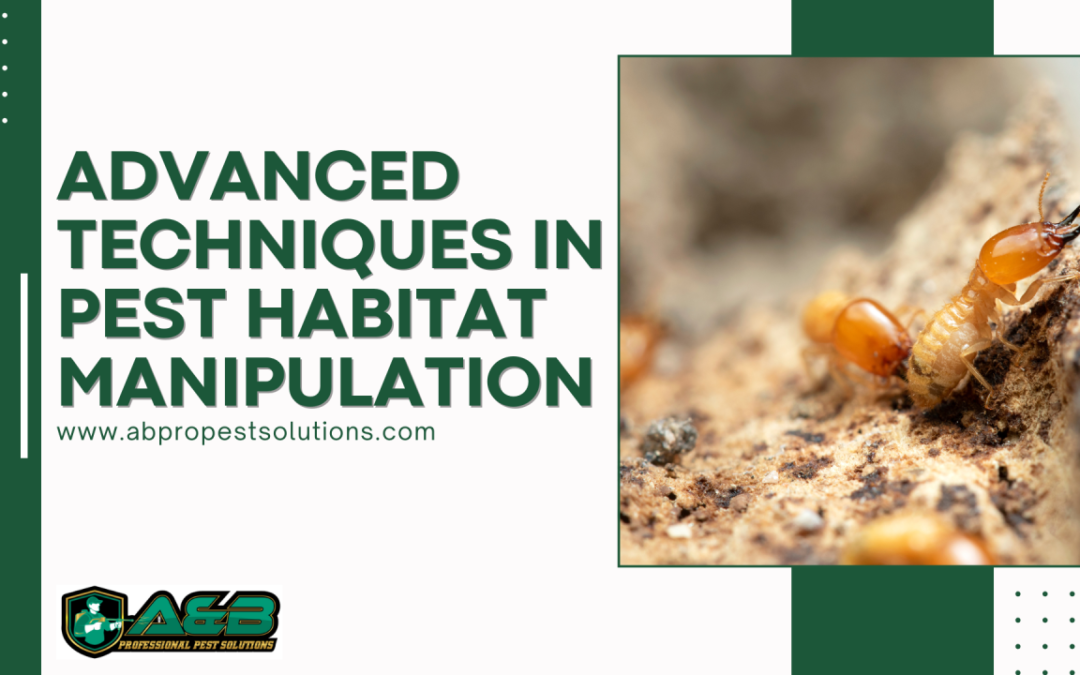In the evolving field of pest management, habitat manipulation has become a cornerstone strategy for achieving sustainable pest control. By altering the environment to make it less hospitable for pests, this approach not only reduces pest populations but also minimizes the need for chemical interventions. Let’s explore the advanced techniques used in habitat manipulation, their benefits, and specific applications across various sectors.
Advanced Techniques in Habitat Manipulation
- Sanitation and Waste Management: Ensuring rigorous sanitation and effective waste management is fundamental. Regular cleaning schedules, proper waste disposal, and maintaining clean storage areas eliminate food sources and breeding grounds, reducing pest attraction and infestation risks.
- Physical Barriers and Exclusion: Installing physical barriers such as screens, door sweeps, and sealing cracks and crevices prevents pests from entering buildings. This method is particularly effective in safeguarding sensitive environments like food processing plants and healthcare facilities.
- Vegetation Management: Proper landscaping around buildings can significantly impact pest populations. Regular maintenance of grass and shrubs, removal of standing water, and ensuring adequate drainage eliminate breeding sites for pests like mosquitoes and rodents, thereby reducing their numbers.
- Environmental Modifications: Adjusting environmental factors such as lighting, temperature, and humidity can deter pests. For example, using yellow sodium vapor lights instead of white mercury vapor lights reduces insect attraction. Maintaining optimal humidity and temperature levels can also create less conducive environments for pests.
- Biological Control: Introducing natural predators or competitors is an effective method. Utilizing beneficial insects, birds, or other animals that prey on pests helps naturally reduce pest populations, supporting biodiversity and reducing reliance on chemical treatments.
- Cultural Practices: Modifying agricultural practices can disrupt pest life cycles. Techniques such as crop rotation, planting pest-resistant varieties, and adjusting irrigation methods can significantly reduce pest pressure, leading to healthier and more resilient crops.
Benefits of Habitat Manipulation
- Sustainable Long-Term Control: Habitat manipulation addresses the root causes of pest infestations, providing a sustainable solution that reduces the likelihood of future problems, unlike temporary chemical treatments.
- Reduced Chemical Dependence: By minimizing the need for pesticides, habitat manipulation promotes a healthier environment and reduces the risk of pests developing resistance to chemicals, supporting organic and eco-friendly practices.
- Cost-Effectiveness: Although the initial investment in habitat modification might be higher, the long-term savings from reduced pest damage, lower pesticide costs, and fewer health issues make it a cost-effective strategy.
- Enhanced Safety and Health: Creating a less pest-friendly environment improves safety and health for occupants, which is especially important in hospitals, schools, and food processing plants where pest-related health risks can be severe.
- Environmental Protection: Habitat manipulation supports ecological balance and reduces the negative impact of chemical treatments on non-target species and the broader environment, aligning with global sustainability goals and corporate social responsibility initiatives.
Sector-Specific Applications
- Food Processing and Manufacturing: Maintaining a sterile and pest-free environment is crucial. Rigorous sanitation, sealing entry points, and controlling environmental factors are essential to prevent contamination and ensure product safety.
- Schools and Hospitals: High standards of hygiene are non-negotiable. Effective waste management systems, regular cleaning schedules, and exclusion techniques protect vulnerable populations from pest-related health risks.
- Agriculture: Farmers benefit from habitat manipulation through practices like crop rotation, planting pest-resistant varieties, and managing irrigation. These techniques disrupt pest life cycles, reduce pest pressure, and improve crop yields and quality.
- Urban Areas: Managing public spaces involves controlling vegetation, ensuring proper waste management, and educating the public on reducing pest attractants. These efforts help maintain a cleaner, safer urban environment, reducing pest-related issues.
Warehousing and Storage: Protecting goods in storage requires stringent habitat manipulation techniques, such as controlling temperature and humidity, sealing entry points, and maintaining cleanliness. These practices prevent infestations and ensure the integrity of stored products.
To know more about A&B’s services, please visit the A&B’s website (www.abpestsolutions.com.ph) or Facebook Page (https://www.facebook.com/ABPestSolutions/) to know more about their services. A&B also disinfects workplaces or houses to kill COVID-19 Virus.
You may also contact: +63 905 496 4550 and +63 951 062 4830
A&B Professional Pest Solutions Corporation is located at the Ground Floor of Monterey Building at Genesis St., Centro de San Lorenzo, Santa Rosa, 4026 Laguna, Philippines

